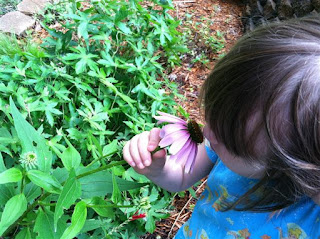 Related to my last post, What's in a Name, about my granddaughter’s mastery of some names of common species while staying with us this summer, I recently discovered that names also can help adults feel that mastery and confidence.
Related to my last post, What's in a Name, about my granddaughter’s mastery of some names of common species while staying with us this summer, I recently discovered that names also can help adults feel that mastery and confidence.Last week, my husband and I took our camper to Johnson’s Shut In’s State Park in Missouri. The plan was to camp, kayak, and hike while the weather was so beautiful. So, one morning we went to Taum Sauk Mountain State Park to hike the trails. I had never been there before and was looking forward to exploring a new site.
Our hike took us past the highest point in Missouri, along the Ozark Trail to Mine Sauk Falls. The terrain was steep and rocky; the habitat was an extensive woodland-glade complex. Because I had worked almost 10 years in the state, I knew what I was looking at and recognized many species. There were lichen grasshoppers and collared lizards, Goat’s Rue and cup and doily spider webs. As we went along the 3 plus mile trail, I rattled off names of species I recognized.....to the point where my husband said, “Are you making all this up!” No I wasn’t.
But I surprised myself at how much I knew about he habitat and species that lived there. For me, it was a source of a feeling of self-confidence and competence, similar to what I’m sure my granddaughter experienced when she recognized a plant or animal that she encountered while staying with us this summer.
So the idea that this type of knowledge brings a certain comfort level in nature was correct, I thought. That is, until we lost the trail! I am a person who can get lost just turning around, so the fact that we had to roam around looking for the trail frightened me. Suddenly, my comfort level evaporated. Fortunately, my husband is a hunter and used to getting from Point A to Point B without a trail.
After looking at the map and my compass app, we decided on a direction and headed out. I was worried that I didn’t have enough food or water to survive in such a wilderness bushwacking through the brush. So as we set off, I was still worried. Perhaps less that 20 yards away, I found the trail. Whew. Relief. I realize I need to practice off trail hiking in order to gain confidence in that realm. I was glad for the experience, though, and I learned that I am comfortable in nature.....as long as there is a trail leading to the car!!!




